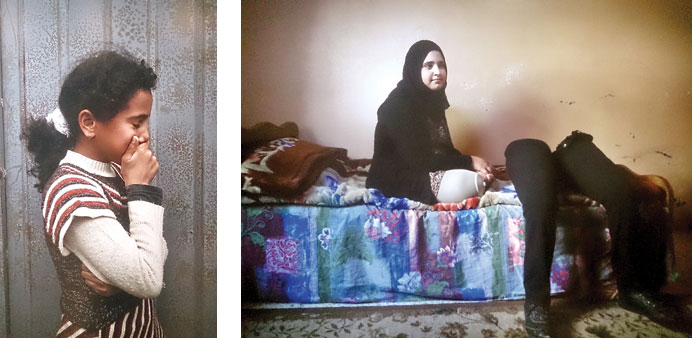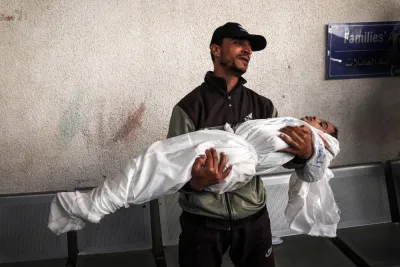A girl going to attend the funeral of her 11-year-old brother in Khan Younis in Gaza.
Jamela al-Habash, with her artificial limbs by her side, dreams of becoming a journalist one day.
It is these images that have made people across the world sit up and demand justice
for those killed and the ones being killed in Gaza right now, writes Umer Nangiana
In one of the most devastating Israeli offensives ongoing against Palestinians in Gaza Strip, humanity has once again come to suffer incalculable losses.
Every time guns rattle, innocents including women and children, die and countless others suffer injuries. And guns, from surface-to-air and vice versa, have been blazing across the Palestinian territories for the past many days.
The magnitude of destruction can only be imagined. The people of Palestine, however, have been going through this ordeal for decades. Every war has inflicted upon them scars deeper than immediate daeath and destruction.
The actual horrors of Israeli-Palestine conflict go far beyond the mere loss of life and property for the people of Gaza, in particular. It is generational, rendering citizens shelter-less and often handicapped with an uncertain future.
With limited access to the occupied territory of Gaza, dubbed as ‘open air prison’, the actual level of devastation would have mostly remained hidden from the outside world if it were not for photographers risking their lives.
It has always been photographical reach that has eventually brought the people of Palestine any relief from the outside world, if at all. With technological advancements and opening of online social services networks, the images of humanity suffering in Gaza captured recently or during the past few years have created an impact never witnessed before.
It is these images that have made people across the world sit up and demand justice for those killed and the ones being killed in Gaza right now. Ali is one such photographer from Palestine who, with his lens, has contributed diligently to people’s knowledge about the horrors of successive wars imposed on Gaza and their after-effects.
In its Building 18, Katara Cultural Village has put on display a selection of Ali’s work on Gaza during the wars of 2008, 2012 and onward that he did for a wire service European Pressphoto Agency (EPA).
They say camera never lies and Ali has proven it right with his work. His photographs on display, mostly taken in the aftermath of the conflicts or immediate post-war scenes, masterfully display the essence of the tragedies his subjects went through.
They show that the photographer has been to the right places at the right times, capturing death, fear, anger and other emotions of hope and hopelessness with clarity and detail.
The selection includes a heart-wrenching image of a teenage girl weeping with her hand on her mouth, trying to keep herself from losing composure while going to attend the funeral of her 11-year-old brother in Khan Younis in Gaza.
“Reports say that Abu Dagah was killed by Israeli forces in Al Farahen east Khan Younis on November 8, 2012 during clashes between Israeli military and Palestinian militants on the border,” Ali states in the description.
Ali has captured young Palestinian boys going about their daily routines around the rubble of their houses. His eye for meaning in the detail of a scene makes his images tell tales. He has simply captured the mood and the emotions of his subjects, either individuals or places, for his audience to interpret the meaning in them.
“Palestinian people warm themselves next to a fire in the rubble of their house that was destroyed in an Israeli air strike on a winter day in Beit Lahiya town Gaza strip on January 8, 2013,” say the pictures, showing two boys chatting beside a fire in the rubble with no signs of worry visible from their faces.
“A massive winter storm has hit the eastern Mediterranean coast and heavy rains with flooding are forecast in Israel and the Palestinian territories for the next couple of days, with a good chance of snow falling in the higher elevations,” the photographer went on to describe under the picture.
Another picture of a young boy pushing his bicycle alongside a dump also captures the immediate attention of the viewers. Describing it, the photographer says the picture was taken at a waste dump in Al-Nusirat Central Gaza strip in 2012.
“The increasing unemployment rate is adding to poverty among Palestinians which heightens tensions in relationship between Hamas in Gaza and Fatah in West Bank,” the caption alludes.
However, the photographer’s best works are close-ups where he has captured the essence with lasting impression. Going through the pictures, you come across this child gazing straight at you with his big eyes. The picture compels you to stop and take a look at it. The boy, introduced to the viewer as Ahmed Faium, has deep intensity.
“The United Nation Relief and Works Agency (UNRWA) states that the Israeli blockade of Gaza has made life more difficult for the inhabitants of the camp. Unemployment levels have increased dramatically with a large proportion of the residents relying on UNRWA’s nutritional and financial assistance, it was reported,” says the caption under the portrait of the boy, who was pictured in front of his home in the Jabaliya Refugee Camp in Northern Gaza Strip in November 2012.
Ali’s camera also introduces to the viewers Jamela al-Habash, a 17-year-old girl, who lost both her legs when her house was shelled by an Israeli tank during the clashes between Israel and Hamas in 2008-09.
Pictured in her family’s home in Jabaliya refugee camp 2012, Al-Habash is shown sitting on a bed with her artificial limbs by her side.
“The exploding shell also killed her nine-year-old sister. Fully supported by her family, especially her two brothers, Momen and Mohammad, with whom she spends most of her time, Jamela currently is studying at a local high school and dreams of completing her studies at a university somewhere to become a journalist,” says the photographer in the description.
Another gripping shot by Ali shows children playing in a cemetery, strolling along graves and hanging around tombstones in their typical childish demeanour. The photographer goes on to explain that Abu Jaber, a Palestinian, and his family comprising two men, two women and the five children, in fact, live in the cemetery in poor conditions.
“Jaber says he lives in the cemetery because he cannot afford healthy housing for himself and his family with just a small daily income from random jobs. He and his children are not employed and are depending on the assistance from the Civil Affairs department of the Government of Gaza,” says the photo caption.
A small girl is pictured standing against a bullet-riddled wall with her toy horse next to her. It is a scene from Bait Lahiya town two days after the UN Aid Agency suspended its cash distribution programme in the Gaza Strip after angry Palestinians stormed its compound in the impoverished enclave to protest cuts.



